Mô hình hóa tương đồng và ứng dụng trong thiết kế thuốc
Trong nhiều thập kỷ qua, mô hình hóa tương đồng đã trở thành công cụ phổ biến để mô hình hóa cấu trúc ba chiều (3D) giả thuyết của các protein quan tâm. Mục đích của quá trình này là để tạo ra cấu trúc 3D của các protein mà cấu trúc vẫn chưa được xác định bằng các phương pháp thực nghiệm.

Trang 1

Trang 2
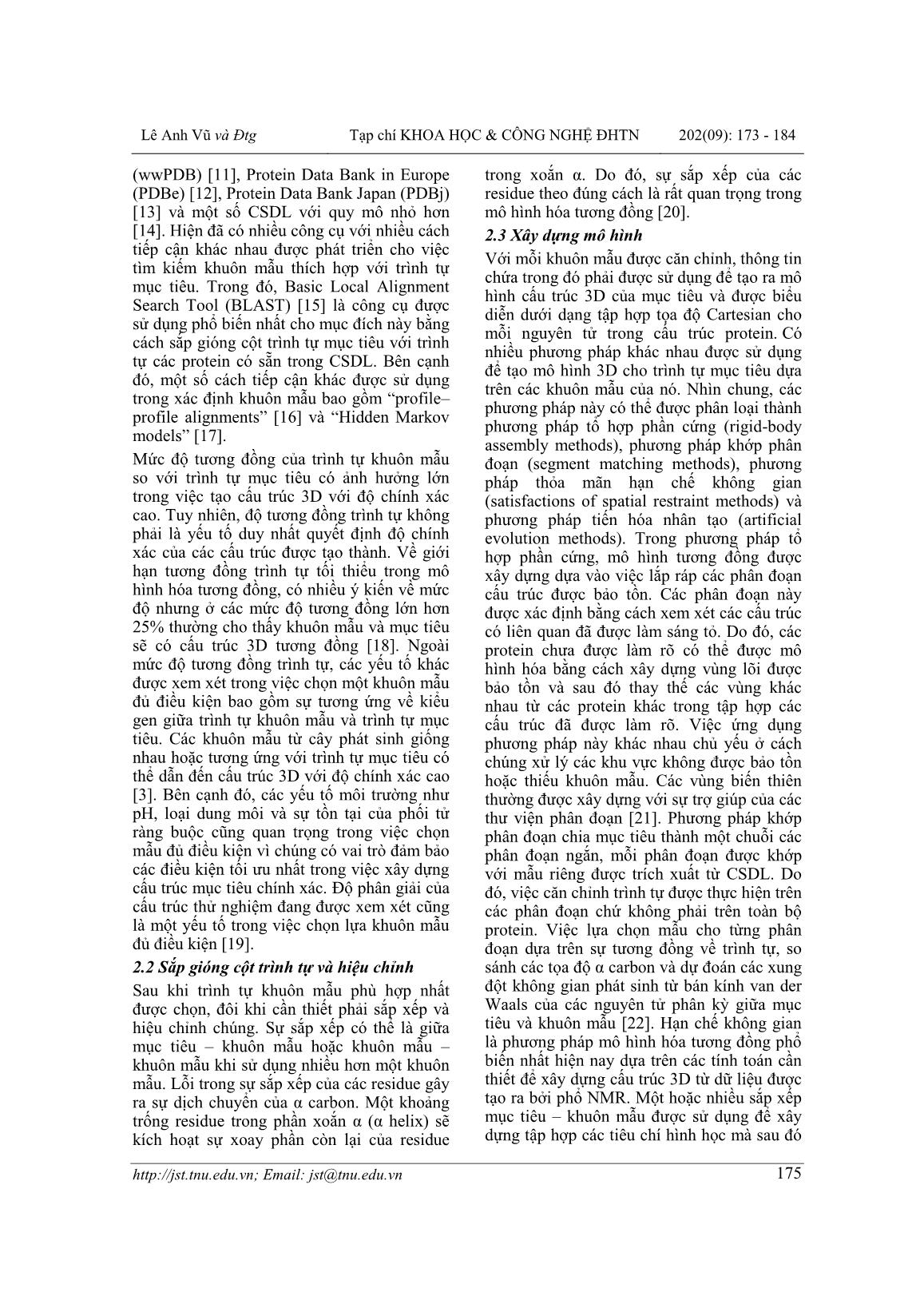
Trang 3
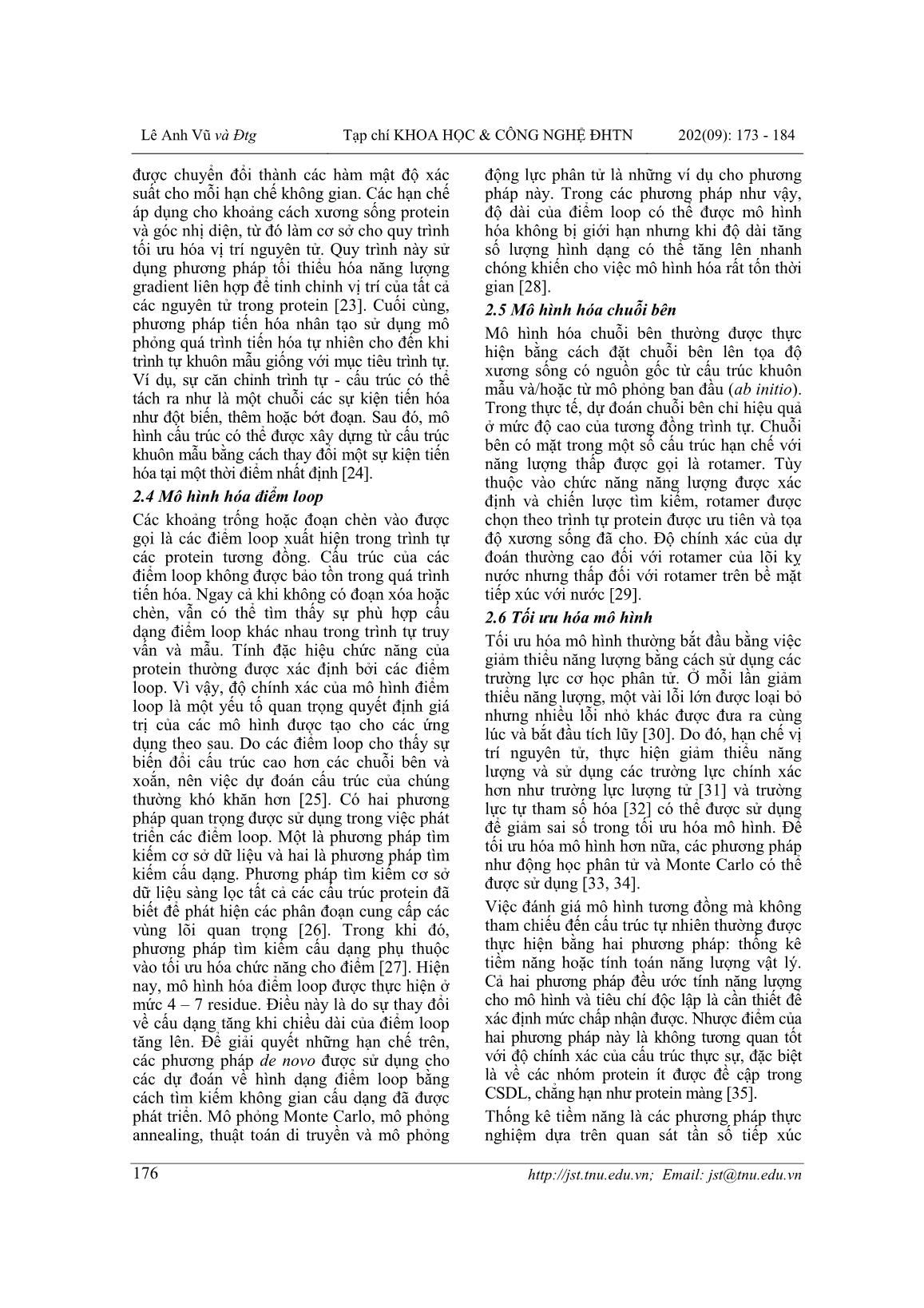
Trang 4
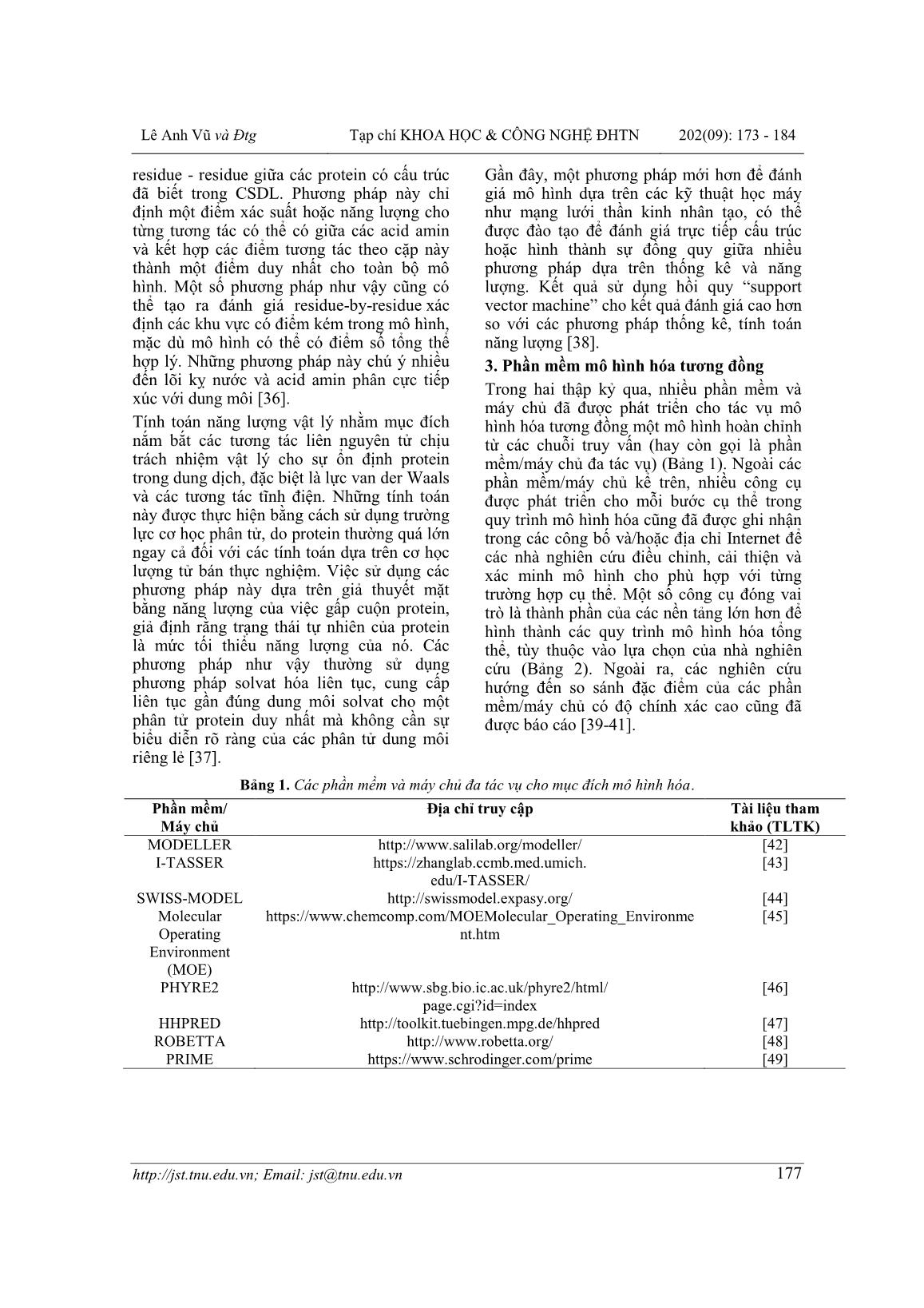
Trang 5
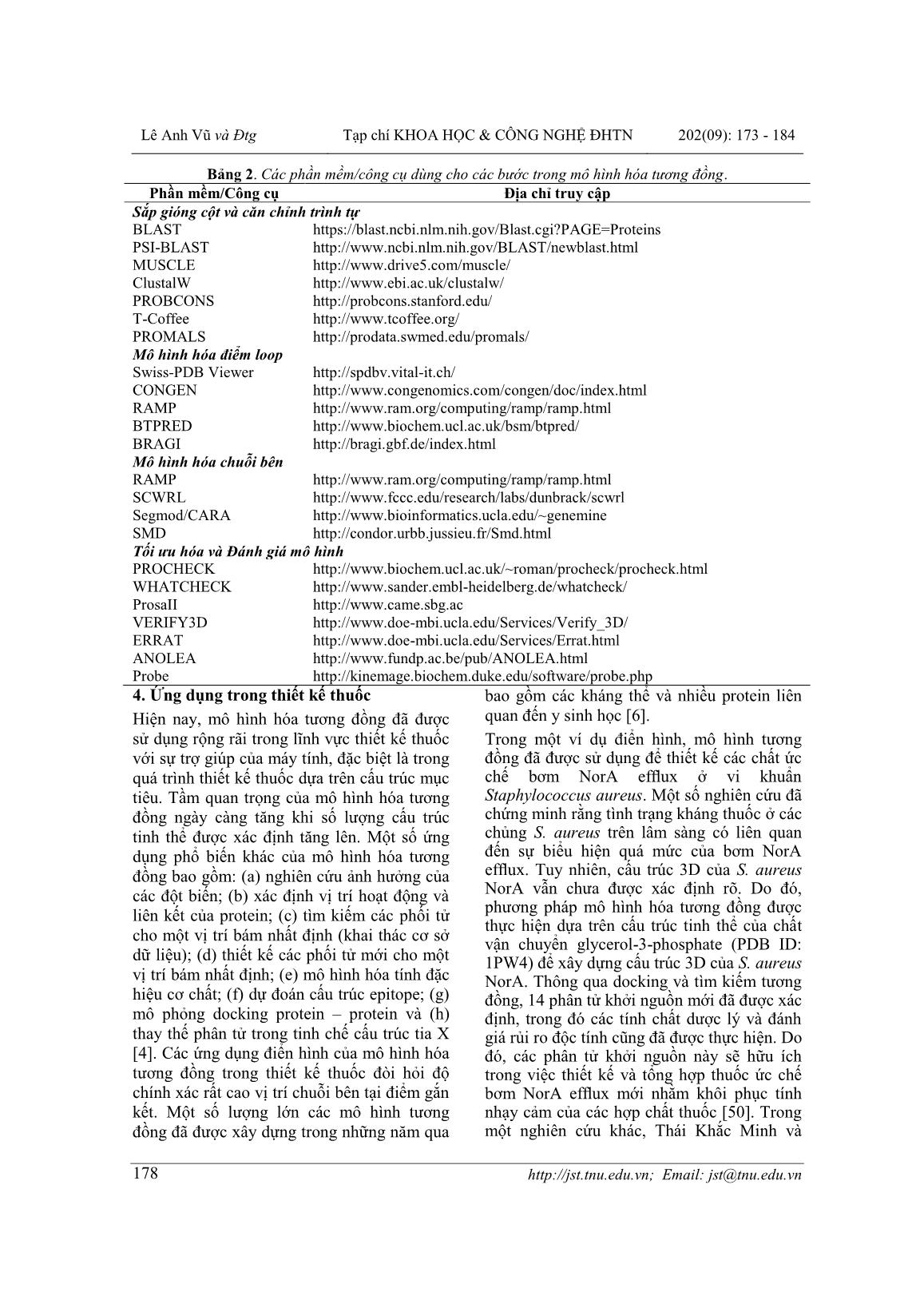
Trang 6
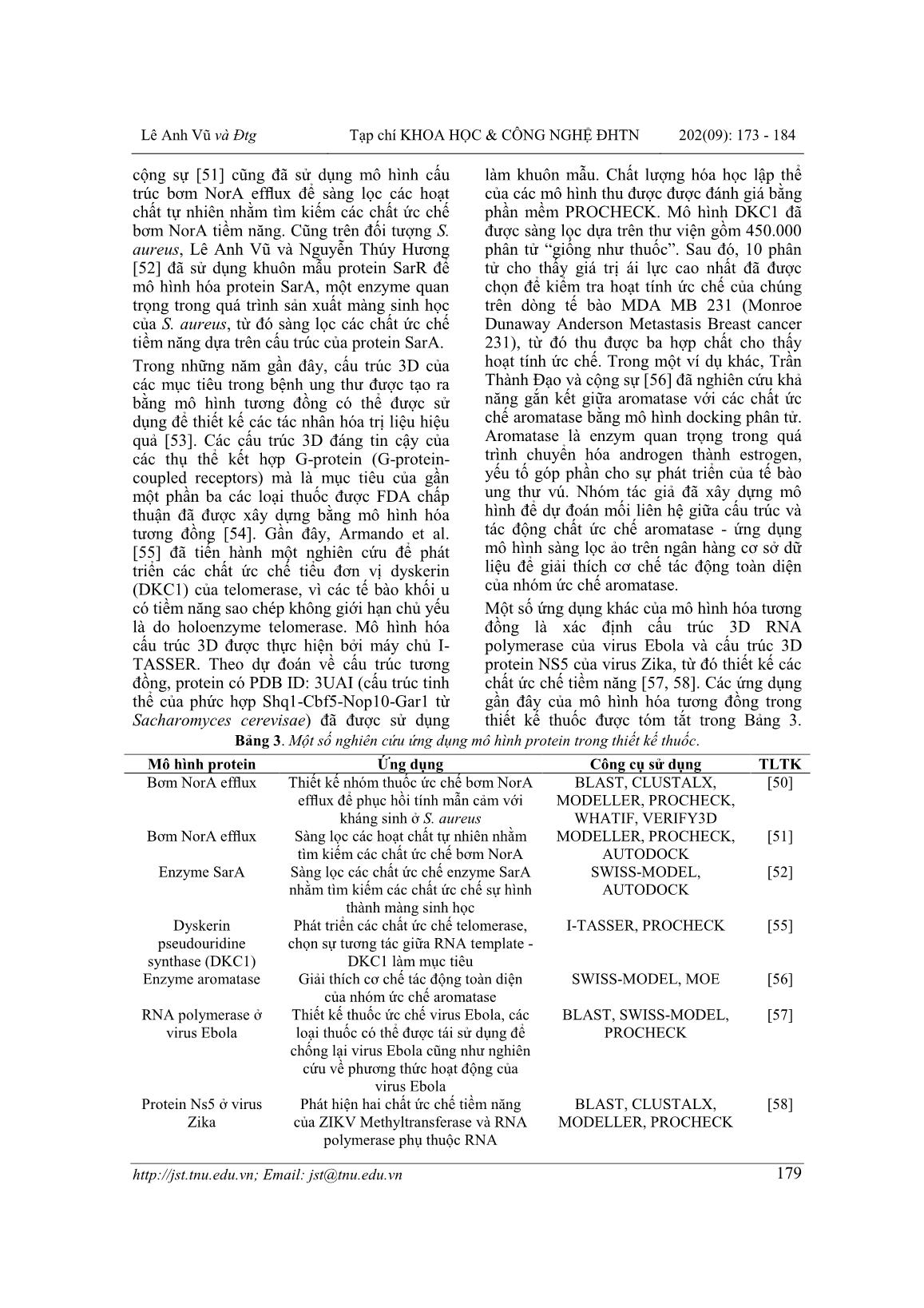
Trang 7
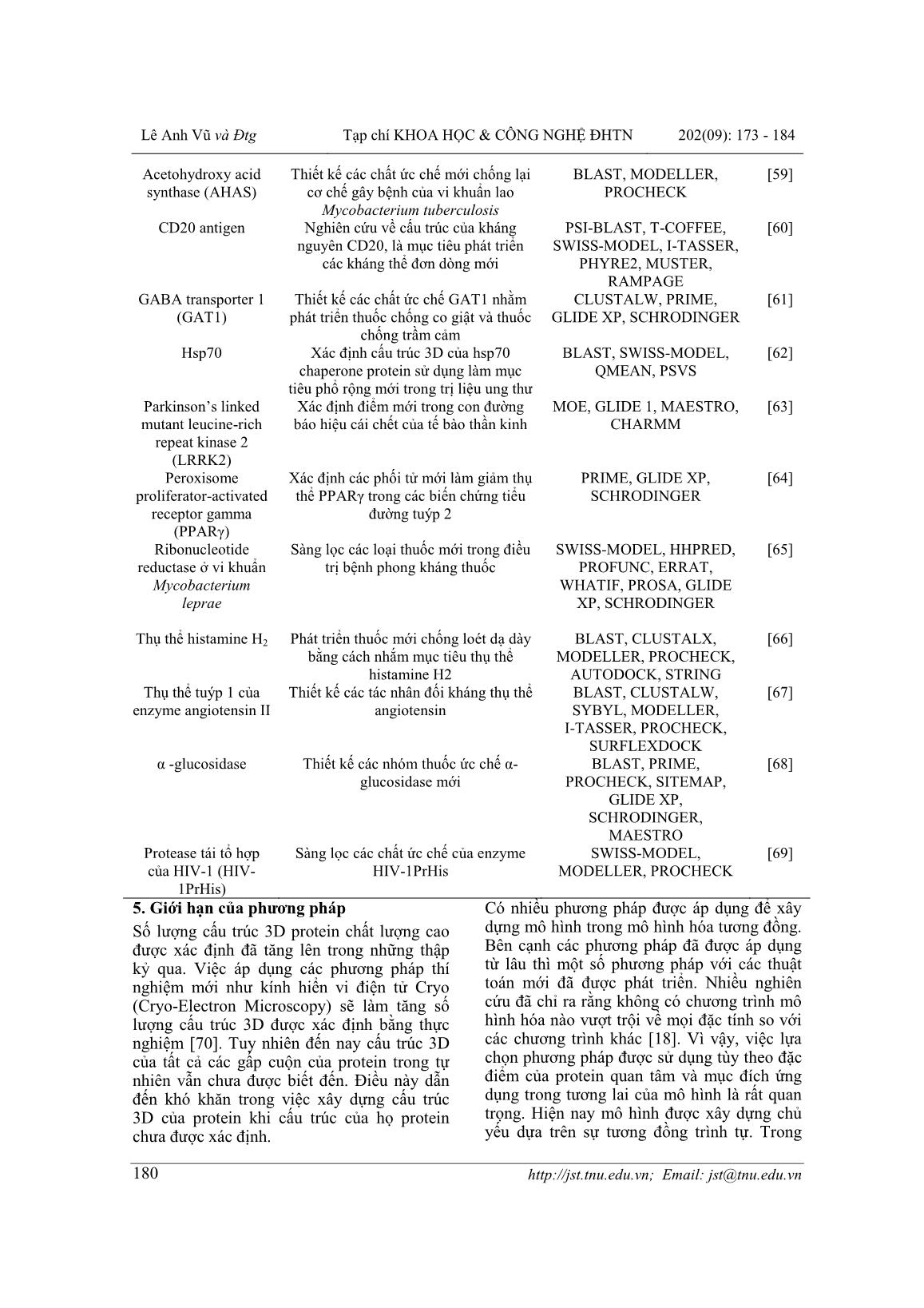
Trang 8
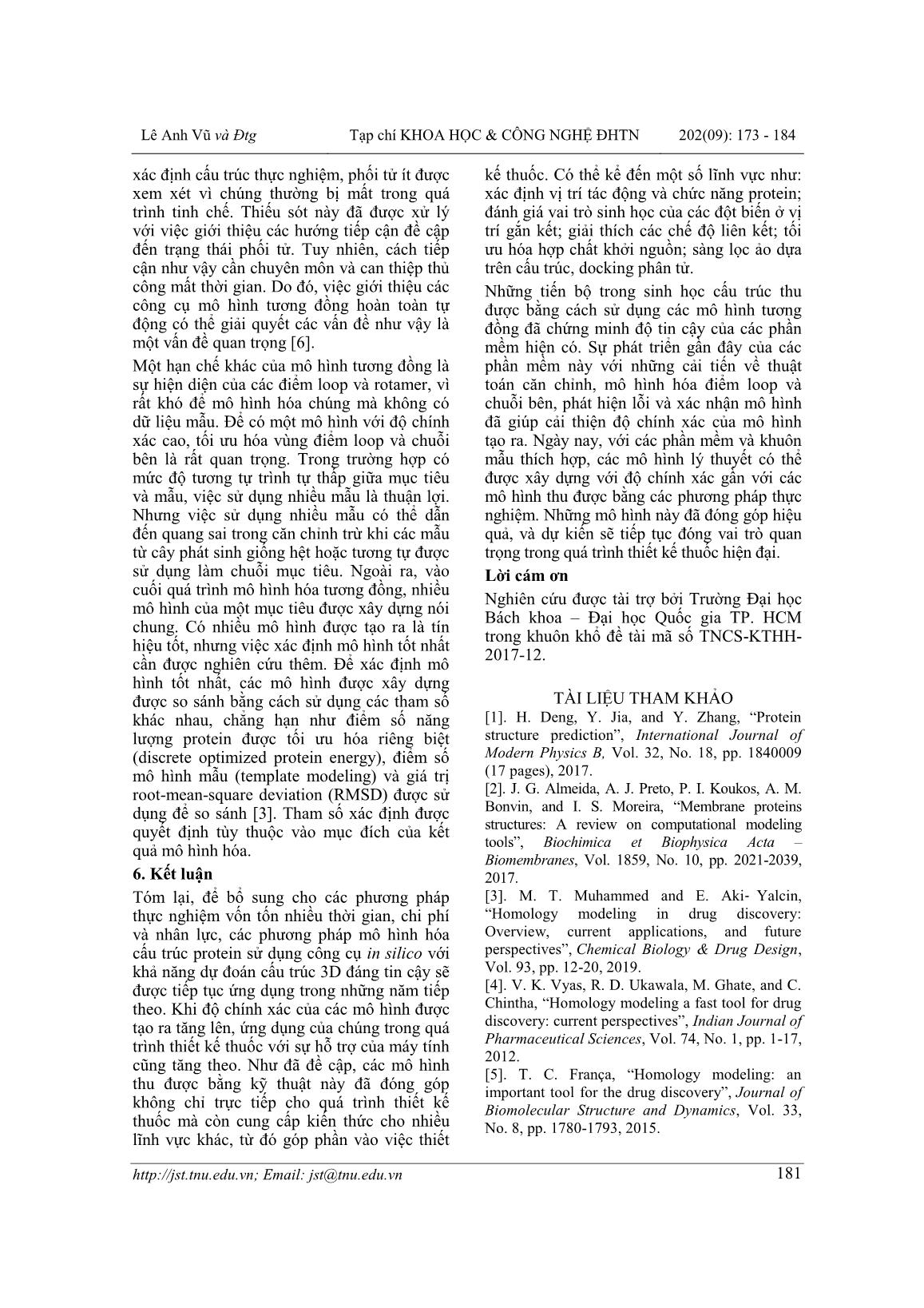
Trang 9
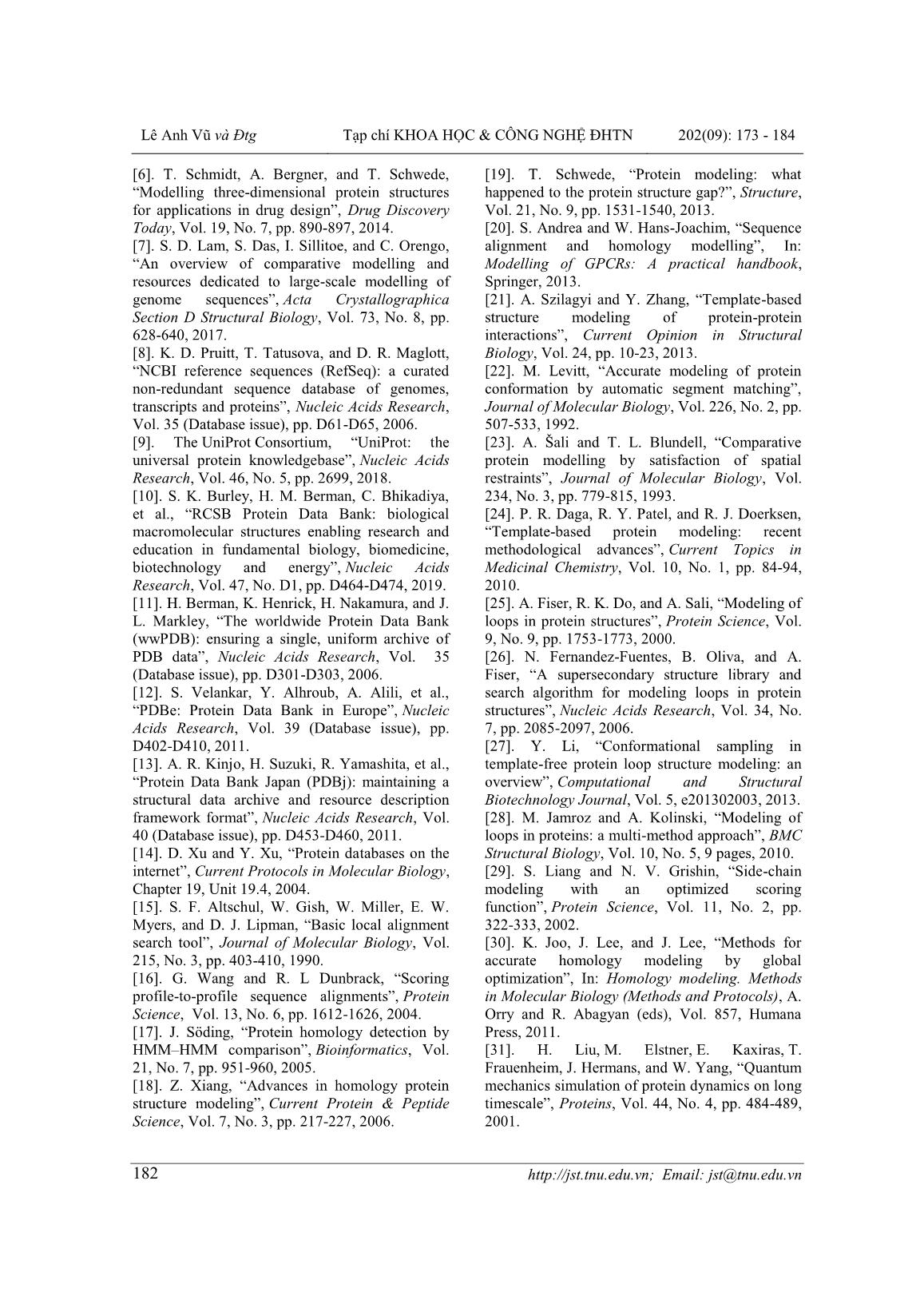
Trang 10
Tải về để xem bản đầy đủ
Bạn đang xem 10 trang mẫu của tài liệu "Mô hình hóa tương đồng và ứng dụng trong thiết kế thuốc", để tải tài liệu gốc về máy hãy click vào nút Download ở trên
Tóm tắt nội dung tài liệu: Mô hình hóa tương đồng và ứng dụng trong thiết kế thuốc
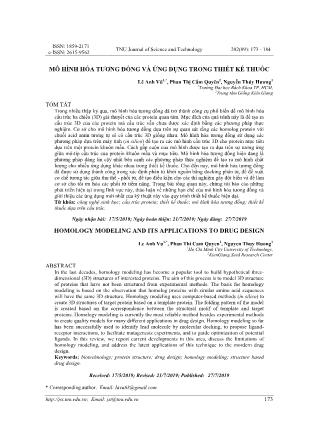
ISSN: 1859-2171 e-ISSN: 2615-9562 TNU Journal of Science and Technology 202(09): 173 - 184 Email: jst@tnu.edu.vn 173 MÔ HÌNH HÓA TƯƠNG ĐỒNG VÀ ỨNG DỤNG TRONG THIẾT KẾ THUỐC Lê Anh Vũ1,*, Phan Thị Cẩm Quyên2, Nguyễn Thúy Hương1 1Trường Đại học Bách Khoa TP. HCM, 2Trung tâm Giống Kiên Giang TÓM TẮT Trong nhiều thập kỷ qua, mô hình hóa tương đồng đã trở thành công cụ phổ biến để mô hình hóa cấu trúc ba chiều (3D) giả thuyết của các protein quan tâm. Mục đích của quá trình này là để tạo ra cấu trúc 3D của các protein mà cấu trúc vẫn chưa được xác định bằng các phương pháp thực nghiệm. Cơ sở cho mô hình hóa tương đồng dựa trên sự quan sát rằng các homolog protein với chuỗi acid amin tương tự sẽ có cấu trúc 3D giống nhau. Mô hình hóa tương đồng sử dụng các phương pháp dựa trên máy tính (in silico) để tạo ra các mô hình cấu trúc 3D cho protein mục tiêu dựa trên một protein khuôn mẫu. Cách gấp cuộn của mô hình được tạo ra dựa trên sự tương ứng giữa mô-típ cấu trúc của protein khuôn mẫu và mục tiêu. Mô hình hóa tương đồng hiện đang là phương pháp đáng tin cậy nhất bên cạnh các phương pháp thực nghiệm để tạo ra mô hình chất lượng cho nhiều ứng dụng khác nhau trong thiết kế thuốc. Cho đến nay, mô hình hóa tương đồng đã được sử dụng thành công trong xác định phân tử khởi nguồn bằng docking phân tử, để đề xuất cơ chế tương tác giữa thụ thể - phối tử, để tạo điều kiện cho các thí nghiệm gây đột biến và để làm cơ sở cho tối ưu hóa các phối tử tiềm năng. Trong bài tổng quan này, chúng tôi báo cáo những phát triển hiện tại trong lĩnh vực này, thảo luận về những hạn chế của mô hình hóa tương đồng và giới thiệu các ứng dụng mới nhất của kỹ thuật này vào quy trình thiết kế thuốc hiện đại. Từ khóa: công nghệ sinh học; cấu trúc protein; thiết kế thuốc; mô hình hóa tương đồng; thiết kế thuốc dựa trên cấu trúc. Ngày nhận bài: 17/5/2019; Ngày hoàn thiện: 21/7/2019; Ngày đăng: 27/7/2019 HOMOLOGY MODELING AND ITS APPLICATIONS TO DRUG DESIGN Le Anh Vu 1,* , Phan Thi Cam Quyen 2 , Nguyen Thuy Huong 1 1Ho Chi Minh City University of Technology, 2KienGiang Seed Research Center ABSTRACT In the last decades, homology modeling has become a popular tool to build hypothetical three- dimensional (3D) structures of interested proteins. The aim of this process is to model 3D structure of proteins that have not been structured from experimental methods. The basis for homology modeling is based on the observation that homolog proteins with similar amino acid sequences will have the same 3D structure. Homology modeling uses computer-based methods (in silico) to create 3D structures of target protein based on a template protein. The folding pattern of the model is created based on the correspondence between the structural motif of template and target proteins. Homology modeling is currently the most reliable method besides experimental methods to create quality models for many different applications in drug design. Homology modeling so far has been successfully used to identify lead molecule by molecular docking, to propose ligand- receptor interactions, to facilitate mutagenesis experiments, and to guide optimization of potential ligands. In this review, we report current developments in this area, discuss the limitations of homology modeling, and address the latest applications of this technique to the mordern drug design. Keywords: biotechnology; protein structure; drug design; homology modeling; structure based drug design. Received: 17/5/2019; Revised: 21/7/2019; Published: 27/7/2019 * Corresponding author. Email: lavu68@gmail.com Lê Anh Vũ và Đtg Tạp chí KHOA HỌC & CÔNG NGHỆ ĐHTN 202(09): 173 - 184 Email: jst@tnu.edu.vn 174 1. Giới thiệu Hiện nay, sự phát triển của các kỹ thuật phân tích cấu trúc như tinh thể học tia X và phổ cộng hưởng từ hạt nhân (NMR) đã cải thiện quá trình xác định cấu trúc lập thể (3D) của protein [1]. Tuy nhiên, những kỹ thuật này hiện vẫn khó có thể được áp dụng cho toàn bộ các protein vì nhiều lý do. Cụ thể, kỹ thuật NMR thường chỉ được áp dụng với các protein có kích thước phân tử nhỏ. Trong trường hợp sử dụng tinh thể học tia X, phân tử protein nên được phân tích dưới dạng kết tinh. Bên cạnh đó, một nhược điểm nữa của các kỹ thuật này là tốn nhiều thời gian và chi phí nghiên cứu. Điều này đã dẫn đến khó khăn trong việc xác định cấu trúc protein với độ phân giải cao, đặc biệt là đối với các protein màng, do những khó khăn trong quá trình tinh chế và kết tinh các protein đó so với các protein hòa tan khác [2]. Vì protein màng chiếm tỷ lệ quan trọng trong các mục tiêu thuốc, những tiến bộ trong việc xác định cấu trúc các protein này dự kiến sẽ đẩy nhanh quá trình thiết kế thuốc. Gần đây, việc dự đoán cấu trúc 3D của protein sử dụng các công cụ in silico đã được phát triển [3]. Mô hình hóa tương đồng là một trong những phương pháp dự đoán cấu trúc in silico được sử dụng để xác định cấu trúc 3D của protein từ trình tự acid amin của nó dựa trên một khuôn mẫu đã biết. Cơ sở cho mô hình hóa tương đồng dựa trên hai luận điểm chính. Đầu tiên, cấu trúc 3D của protein được xác định bởi trình tự acid amin của nó. Thứ hai, cấu trúc của protein được bảo tồn nhiều hơn và sự thay đổi thường xảy ra với tốc độ chậm hơn nhiều so với trình tự acid amin trong quá trình tiến hóa. Kết quả là các trình tự tương đồng thường gấp cuộn thành các cấu trúc tương tự nhau và thậm chí các trình tự có mức liên quan thấp vẫn có thể có cấu trúc 3D tương tự [4]. Do đó, mô hình hóa tương đồng đã được sử dụng để mô phỏng các cấu trúc 3D với độ chính xác cao [1]. Ngoài ra, kỹ thuật này còn có ưu điểm là cần ít thời gian và chi phí thấp hơn so với các phương pháp truyền thống. Điều này đã làm thay đổi cách thức tiến hành docking và thúc đẩy ứng dụng của sàng lọc ảo dựa trên cấu trúc trong quy trình thiết kế thuốc hiện đại [5]. Đã có đ ... iology & Drug Design, Vol. 93, pp. 12-20, 2019. [4]. V. K. Vyas, R. D. Ukawala, M. Ghate, and C. Chintha, “Homology modeling a fast tool for drug discovery: current perspectives”, Indian Journal of Pharmaceutical Sciences, Vol. 74, No. 1, pp. 1-17, 2012. [5]. T. C. França, “Homology modeling: an important tool for the drug discovery”, Journal of Biomolecular Structure and Dynamics, Vol. 33, No. 8, pp. 1780-1793, 2015. Lê Anh Vũ và Đtg Tạp chí KHOA HỌC & CÔNG NGHỆ ĐHTN 202(09): 173 - 184 Email: jst@tnu.edu.vn 182 [6]. T. Schmidt, A. Bergner, and T. Schwede, “Modelling three-dimensional protein structures for applications in drug design”, Drug Discovery Today, Vol. 19, No. 7, pp. 890-897, 2014. [7]. S. D. Lam, S. Das, I. Sillitoe, and C. Orengo, “An overview of comparative modelling and resources dedicated to large-scale modelling of genome sequences”, Acta Crystallographica Section D Structural Biology, Vol. 73, No. 8, pp. 628-640, 2017. [8]. K. D. Pruitt, T. Tatusova, and D. R. Maglott, “NCBI reference sequences (RefSeq): a curated non-redundant sequence database of genomes, transcripts and proteins”, Nucleic Acids Research, Vol. 35 (Database issue), pp. D61-D65, 2006. [9]. The UniProt Consortium, “UniProt: the universal protein knowledgebase”, Nucleic Acids Research, Vol. 46, No. 5, pp. 2699, 2018. [10]. S. K. Burley, H. M. Berman, C. Bhikadiya, et al., “RCSB Protein Data Bank: biological macromolecular structures enabling research and education in fundamental biology, biomedicine, biotechnology and energy”, Nucleic Acids Research, Vol. 47, No. D1, pp. D464-D474, 2019. [11]. H. Berman, K. Henrick, H. Nakamura, and J. L. Markley, “The worldwide Protein Data Bank (wwPDB): ensuring a single, uniform archive of PDB data”, Nucleic Acids Research, Vol. 35 (Database issue), pp. D301-D303, 2006. [12]. S. Velankar, Y. Alhroub, A. Alili, et al., “PDBe: Protein Data Bank in Europe”, Nucleic Acids Research, Vol. 39 (Database issue), pp. D402-D410, 2011. [13]. A. R. Kinjo, H. Suzuki, R. Yamashita, et al., “Protein Data Bank Japan (PDBj): maintaining a structural data archive and resource description framework format”, Nucleic Acids Research, Vol. 40 (Database issue), pp. D453-D460, 2011. [14]. D. Xu and Y. Xu, “Protein databases on the internet”, Current Protocols in Molecular Biology, Chapter 19, Unit 19.4, 2004. [15]. S. F. Altschul, W. Gish, W. Miller, E. W. Myers, and D. J. Lipman, “Basic local alignment search tool”, Journal of Molecular Biology, Vol. 215, No. 3, pp. 403-410, 1990. [16]. G. Wang and R. L Dunbrack, “Scoring profile-to-profile sequence alignments”, Protein Science, Vol. 13, No. 6, pp. 1612-1626, 2004. [17]. J. Söding, “Protein homology detection by HMM–HMM comparison”, Bioinformatics, Vol. 21, No. 7, pp. 951-960, 2005. [18]. Z. Xiang, “Advances in homology protein structure modeling”, Current Protein & Peptide Science, Vol. 7, No. 3, pp. 217-227, 2006. [19]. T. Schwede, “Protein modeling: what happened to the protein structure gap?”, Structure, Vol. 21, No. 9, pp. 1531-1540, 2013. [20]. S. Andrea and W. Hans-Joachim, “Sequence alignment and homology modelling”, In: Modelling of GPCRs: A practical handbook, Springer, 2013. [21]. A. Szilagyi and Y. Zhang, “Template-based structure modeling of protein-protein interactions”, Current Opinion in Structural Biology, Vol. 24, pp. 10-23, 2013. [22]. M. Levitt, “Accurate modeling of protein conformation by automatic segment matching”, Journal of Molecular Biology, Vol. 226, No. 2, pp. 507-533, 1992. [23]. A. Šali and T. L. Blundell, “Comparative protein modelling by satisfaction of spatial restraints”, Journal of Molecular Biology, Vol. 234, No. 3, pp. 779-815, 1993. [24]. P. R. Daga, R. Y. Patel, and R. J. Doerksen, “Template-based protein modeling: recent methodological advances”, Current Topics in Medicinal Chemistry, Vol. 10, No. 1, pp. 84-94, 2010. [25]. A. Fiser, R. K. Do, and A. Sali, “Modeling of loops in protein structures”, Protein Science, Vol. 9, No. 9, pp. 1753-1773, 2000. [26]. N. Fernandez-Fuentes, B. Oliva, and A. Fiser, “A supersecondary structure library and search algorithm for modeling loops in protein structures”, Nucleic Acids Research, Vol. 34, No. 7, pp. 2085-2097, 2006. [27]. Y. Li, “Conformational sampling in template-free protein loop structure modeling: an overview”, Computational and Structural Biotechnology Journal, Vol. 5, e201302003, 2013. [28]. M. Jamroz and A. Kolinski, “Modeling of loops in proteins: a multi-method approach”, BMC Structural Biology, Vol. 10, No. 5, 9 pages, 2010. [29]. S. Liang and N. V. Grishin, “Side-chain modeling with an optimized scoring function”, Protein Science, Vol. 11, No. 2, pp. 322-333, 2002. [30]. K. Joo, J. Lee, and J. Lee, “Methods for accurate homology modeling by global optimization”, In: Homology modeling. Methods in Molecular Biology (Methods and Protocols), A. Orry and R. Abagyan (eds), Vol. 857, Humana Press, 2011. [31]. H. Liu, M. Elstner, E. Kaxiras, T. Frauenheim, J. Hermans, and W. Yang, “Quantum mechanics simulation of protein dynamics on long timescale”, Proteins, Vol. 44, No. 4, pp. 484-489, 2001. Lê Anh Vũ và Đtg Tạp chí KHOA HỌC & CÔNG NGHỆ ĐHTN 202(09): 173 - 184 Email: jst@tnu.edu.vn 183 [32]. E. Krieger, G. Koraimann, and G. Vriend, “Increasing the precision of comparative models with YASARA NOVA - a self-parameterizing force field”, Proteins, Vol. 47, No. 3, pp. 393-402, 2002. [33]. H. Fan and A. E. Mark, “Refinement of homology-based protein structures by molecular dynamics simulation techniques”, Protein Science, Vol. 13, No. 1, pp. 211-220, 2004. [34]. C. Guda, E. D Scheeff, P. E. Bourne, and I. N. Shindyalov, “A new algorithm for the alignment of multiple protein structures using Monte Carlo optimization”, Pacific Symposium on Biocomputing, pp. 275-286, 2001. [35]. A. Kryshtafovych and K. Fidelis, “Protein structure prediction and model quality assessment”, Drug Discovery Today, Vol. 14, No. 7-8, pp. 386-393, 2009. [36]. M. Y. Shen and A. Sali, “Statistical potential for assessment and prediction of protein structures”, Protein Science, Vol. 15, No. 11, pp. 2507-2024, 2006. [37]. S. Crivelli, E. Eskow, B. Bader, et al., “A physical approach to protein structure prediction”, Biophysical Journal, Vol. 82, No. 1, pp. 36-49, 2002. [38]. J. Cheng, A. N. Tegge, and P. Baldi, “Machine learning methods for protein structure prediction”, IEEE Reviews in Biomedical Engineering, Vol. 1, pp. 41-49, 2008. [39]. A. Nayeem, D. Sitkoff and S. Krystek, “A comparative study of available software for high- accuracy homology modeling: from sequence alignments to structural models”, Protein Science, Vol. 15, No. 4, pp. 808-824, 2006. [40]. A. Saxena, R. S. Sangwan, and S. Mishra, “Fundamentals of homology modeling steps and comparison among important bioinformatics tools: an overview”, Science International, Vol. 1, pp. 237-252, 2013. [41]. H. J. Hasani and K. Barakat, “Homology modeling: an overview of fundamentals and tools”, International Review on Modelling and Simulations (IREMOS), Vol. 10, No. 2, pp. 129- 145, 2017. [42]. A. Webb and A. Sali, “Comparative protein structure modeling using MODELLER”, Current Protocols in Bioinformatics, Vol. 54, pp. 5.6.1– 5.6.37, 2016. [43]. J. Yang and Y. Zhang, “Protein structure and function prediction using I-TASSER”, Current Protocols in Bioinformatics, Vol. 52, pp. 5.8.1– 5.8.15, 2015. [44]. T. Schwede, J. Kopp, N. Guex, and M. C. Peitsch, “SWISS-MODEL: An automated protein homology-modeling server”, Nucleic Acids Research, Vol. 31, No. 13, pp. 3381-3385, 2003. [45]. Molecular Operating Environment (MOE) Montreal, QC: Chemical Computing Group Inc; 2013. [46]. L. A. Kelley, S. Mezulis, C. M. Yates, M. N. Wass, and M. J. Sternberg, “The Phyre2 web portal for protein modeling, prediction and analysis”, Nature Protocols, Vol. 10, No. 6, pp. 845-858, 2015. [47]. J. Söding, A. Biegert, and A. N. Lupas, “The HHpred interactive server for protein homology detection and structure prediction”, Nucleic Acids Research, Vol. 33 (Web Server issue), pp. W244- W248, 2005. [48]. D. E. Kim, D. Chivian, and D. Baker, “Protein structure prediction and analysis using the Robetta server”, Nucleic Acids Research, Vol. 32 (Web Server issue), pp. W526-W531, 2004. [49]. Schrödinger, Prime. ‘Version 3.5.’. New York: LLC; 2014. [50]. A. V. Bhaskar, T. M. Babu, N. V. Reddy, and W. Rajendra, “Homology modeling, molecular dynamics, and virtual screening of NorA efflux pump inhibitors of Staphylococcus aureus”, Drug Design, Development and Therapy, Vol. 10, pp. 3237-3252, 2016. [51]. Khac-Minh Thai, Trieu-Du Ngo, Thien-Vy Phan, Thanh-Dao Tran, Ngoc-Vinh Nguyen, Thien-Hai Nguyen and Minh-Tri Le, “Virtual Screening for Novel Staphylococcus aureus NorA Efflux Pump Inhibitors from Natural Products”, Medicinal Chemistry, Vol. 11, No. 2, pp. 135-155, 2015. [52]. Anh-Vu Le and Thuy-Huong Nguyen, “Structure Based Drug Design of Inhibitors for Staphylococcus aureus Biofilm”, International Journal of Modern Engineering Research, Vol. 5, No. 9, pp. 10-17, 2015. [53]. A. N. Cavasotto, S. S. Phatak, “Homology modeling in drug discovery: current trends and applications”, Drug Discovery Today, Vol. 14, No. 13-14, pp. 676-683, 2009. [54]. A. Kufareva, M. Rueda, V. Katritch, R. C. Stevens, and R. Abagyan, “Status of GPCR modeling and docking as reflected by community- wide GPCR Dock 2010 assessment”, Structure, Vol. 19, No. 8, pp. 1108-1026, 2011. [55]. R. G. Armando, D. L. Mengual Gómez, E. I. Juritz, P. Lorenzano Menna, and D. E. Gomez, “Homology model and docking-based virtual screening for ligands of human dyskerin as new inhibitors of telomerase for cancer treatment”, International Journal of Molecular Sciences, Vol. 19, No. 10, pp. 3216, 2018. Lê Anh Vũ và Đtg Tạp chí KHOA HỌC & CÔNG NGHỆ ĐHTN 202(09): 173 - 184 Email: jst@tnu.edu.vn 184 [56]. Trần Thành Đạo, Lê Minh Trí, Thái Khắc Minh, “Nghiên cứu mô hình QSAR và mô tả phân tử docking các chất ức chế aromatase”, Tạp chí Dược học, T. 59,S. 3, trang 43-47, 2019. [57]. M. Balmith, M. Faya, and M. E. Soliman, “Ebola virus: A gap in drug design and discovery ‐ experimental and computational perspective”, Chemical Biology & Drug Design, Vol. 89, No. 3, pp. 297-308, 2017. [58]. P. Ramharack, and M. E. S. Soliman, “Zika virus NS5 protein potential inhibitors: an enhanced in silico approach in drug discovery”, Journal of Biomolecular Structure and Dynamics, Vol. 36, No. 5, pp. 1118-1133, 2018. [59]. K. Gokhale and B. Tilak, “Mechanisms of bacterial acetohydroxyacid synthase (AHAS) and specific inhibitors of Mycobacterium tuberculosis AHAS as potential drug candidates against tuberculosis”, Current Drug Targets, Vol. 16, No. 7, pp. 689-699, 2015. [60]. Z. Payandeh, M. Rajabibazl, Y. Mortazavi, A. Rahimpour, and A. H. Taromchi, “Ofatumumab monoclonal antibody affinity maturation through in silico modeling”, Iranian Biomedical Journal, Vol. 22, No. 3, pp. 180-192, 2018. [61]. R. B. Singh, G. K. Singh, K. Chaturvedi, et al., “Design, synthesis, characterization, and molecular modeling studies of novel oxadiazole derivatives of nipecotic acid as potential anticonvulsant and antidepressant agents”, Medicinal Chemistry Research, Vol. 27, No. 1, pp. 137-152, 2018. [62]. S. Mishra and V. Gomase, “Computational comparative homology based 3D-structure modelling of the HSp70 Protein from GWD”, Journal of Health and Medical Informatics, Vol. 7, No. 3, pp. 233-239, 2016. [63]. N. Antoniou, D. Vlachakis, A. Memou, et al., “A motif within the armadillo repeat of Parkinson's-linked LRRK2 interacts with FADD to hijack the extrinsic death pathway”, Scientific Reports, Vol. 8, No. 1, pp. 3455, 2018. [64]. S. Prabhu, S. Vijayakumar, P. Manogar, G. P. Maniam, and N. Govindan, “Homology modeling and molecular docking studies on Type II diabetes complications reduced PPARγ receptor with various ligand molecules”, Biomedicine & Pharmacotherapy, Vol. 92, pp. 528-535, 2017. [65]. P. S. Mohanty, A. K. Bansal, F. Naaz, U. D. Gupta, V. D. Dwivedi, and U. Yadava, “Ribonucleotide reductase as a drug target against drug resistance Mycobacterium leprae: A molecular docking study”, Infection, Genetics and Evolution, Vol. 60, pp. 58-65, 2018. [66]. V. Singh, N. Gohil, and R. Ramírez‐ García, “New insight into the control of peptic ulcer by targeting the histamine H2 receptor”, Journal of Cellular Biochemistry, Vol. 119, No. 2, pp. 2003-2011, 2018. [67]. V. K. Vyas, M. Ghate, K. Patel, G. Qureshi, and S. Shah, “Homology modeling, binding site identification and docking study of human angiotensin II type I (Ang II-AT1) receptor”, Biomedicine & Pharmacotherapy, Vol. 74, pp. 42- 48, 2015. [68]. N. C. Jadhav, A. R. Pahelkar, N. V. Desai, et al., “Design, synthesis and molecular docking study of novel pyrrole-based α-amylase and α- glucosidase inhibitors”, Medicinal Chemistry Research, Vol. 26, No. 10, pp. 2675-2691, 2017. [69]. Nguyễn Thị Hồng Loan, Nguyễn Văn Sáng, Trịnh Hồng Thái, Phan Tuấn Nghĩa, Bùi Phương Thuận, “Một số đặc điểm cấu trúc của protease HIV-1 tái tổ hợp”, Tạp chí Sinh học, T. 34, S. 4, trang 520 -527, 2016. [70]. T. R. D. Costa, A. Ignatiou, and E. V. Orlova, “Structural analysis of protein complexes by cryo electron microscopy”. In: Bacterial Protein Secretion Systems. Methods in Molecular Biology, L. Journet and E. Cascales (eds), Vol. 1615, Humana Press, New York, 2017.
File đính kèm:
 mo_hinh_hoa_tuong_dong_va_ung_dung_trong_thiet_ke_thuoc.pdf
mo_hinh_hoa_tuong_dong_va_ung_dung_trong_thiet_ke_thuoc.pdf

